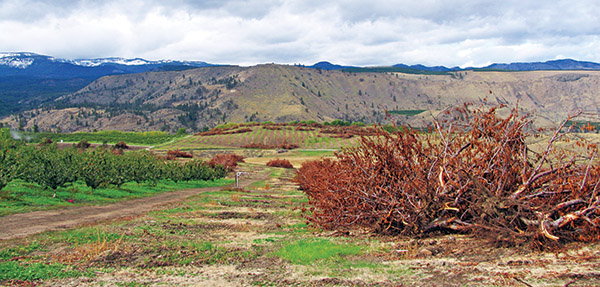
Removal of a Washington orchard infected with little cherry virus in 2014. (Courtesy Tim Smith)
There’s much still to learn about little cherry virus, but one thing is certain. Infected trees need to be removed as soon as possible, says Tim Smith, Washington State University Extension specialist.
Little cherry virus is a serious disease that spreads quickly. Some years ago, growers thought the main concern was small fruit. But Smith said there’s a big difference between naturally small cherries and virus-infected cherries.
Symptoms are visible only during the lead up to harvest when fruit on infected trees will be smaller and paler than fruit on healthy trees. Sometimes the cherries are pointed, with flat sides. On Rainier cherry trees, the fruit will be white, making it easy to diagnose.
Trees infected with Western X disease will have fruit of various colors, whereas trees with little cherry virus will have fruit that are more uniformly lacking in color.
The cherries also have a bitter taste, which Smith said is the way he diagnoses little-cherry-virus affected trees. Fruit quality will not improve once the tree has the virus.
The rest of the year, the trees will look quite healthy, with large, glossy, well-formed leaves, which is why it’s important to look for symptoms around harvest. The virus might affect only certain limbs, or the whole tree.
The virus typically starts on an outside row of the orchard and spreads quickly, moving more rapidly across rows than down rows. The pollinizer variety Black Republican seems particularly susceptible, Smith said. “I’ve seen it spread across an orchard in three to four years where they neglected to remove the trees.”
Hot spot
It used to be thought that spread of the disease was linked to the weather in the spring, but Smith said that in recent years it’s continued to spread regardless of whether the spring was hot or cool. Many more orchards were found to be infected in 2014.
The Wenatchee area seems to be the hot spot for the disease, although it has also been seen as far north as Tonasket and in southern parts of the state.
Hundreds of acres of cherry orchards have been removed, but still more need to come out, Smith said. “This cannot be cured by any product or treatment. You have to pull the tree.
“There are still people who think this is not happening and are not pulling out their trees. It’s going to get worse in this industry before it gets better. There are hundreds of acres left to come out.”
He suggested that a coordinated effort to remove diseased trees might be needed. The virus can spread across highways, and if a grower removes an orchard and replants it, there’s the risk of reinfection from a neighboring orchard.
“Taking out an orchard and putting it back into a cherry orchard is a risky situation,” he said. “We need to find out more about this disease because it has the ability to spread to a new orchard from an existing orchard—or maybe it’s in the soil. We can spend the next 10 years trading the virus back and forth or we can clean up the community.” •






Leave A Comment